Analysis of Clinical Communication in Healthcare: A Literature Review
VerifiedAdded on 2023/06/03
|11
|1565
|91
Literature Review
AI Summary
This literature review examines clinical communication within healthcare settings, highlighting its importance in patient care, error reduction, and overall satisfaction. It discusses the exchange of information between healthcare staff and patients, emphasizing the need for effective communication strategies. The review analyzes various studies and surveys, revealing challenges such as overburdened communication, lack of awareness, and improper technology use. It also explores ways to improve communication through training programs, feedback mechanisms, and the implementation of appropriate technologies. The literature suggests that good communication fosters better patient outcomes, reduces stress for healthcare providers, and enhances job satisfaction. Furthermore, the review touches upon theories related to nurse-patient relationships and the critical role of frontline team members in addressing patient needs. The conclusion underscores the significance of clear and open communication in preventing medication errors, improving patient recovery, and ensuring a safe and respectful environment.
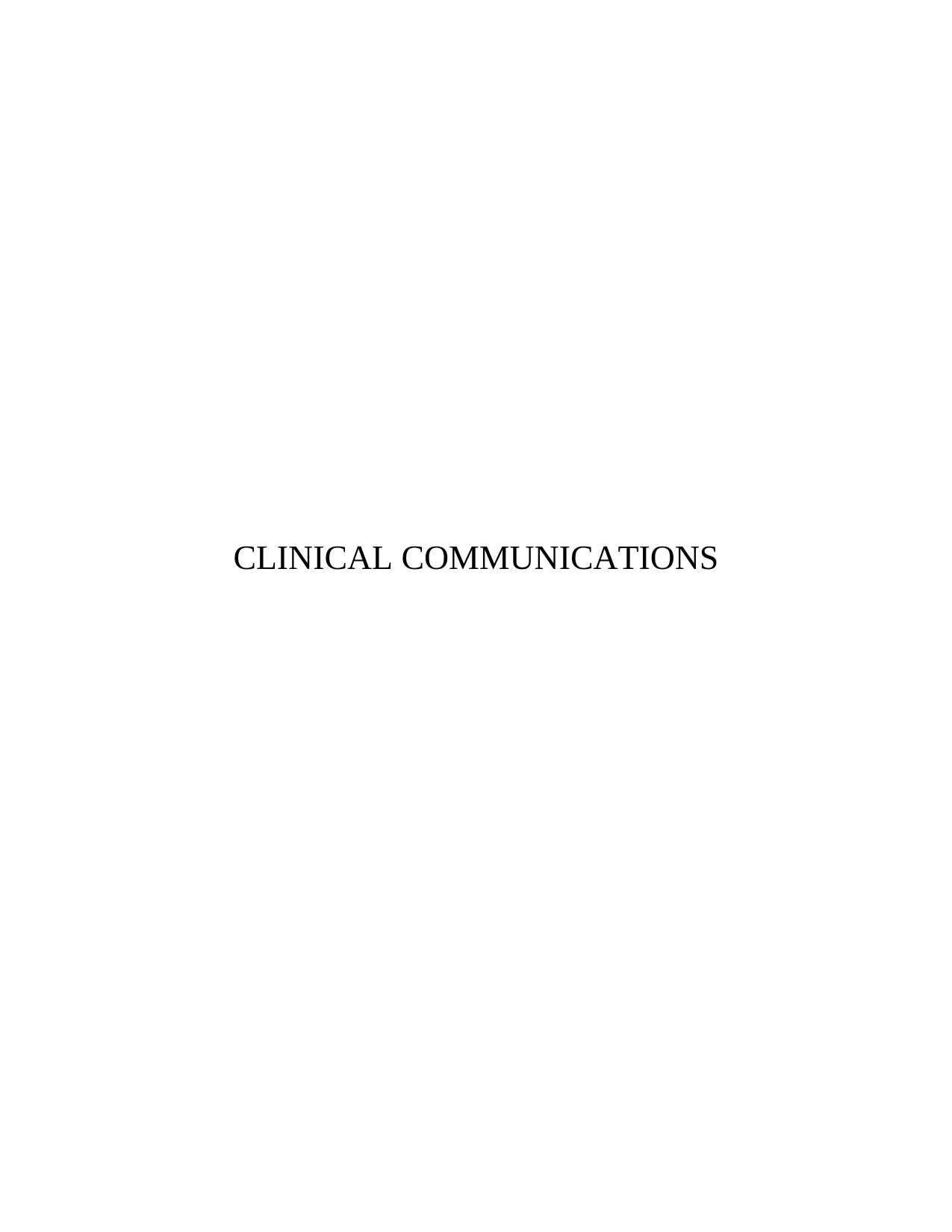
CLINICAL COMMUNICATIONS
Paraphrase This Document
Need a fresh take? Get an instant paraphrase of this document with our AI Paraphraser
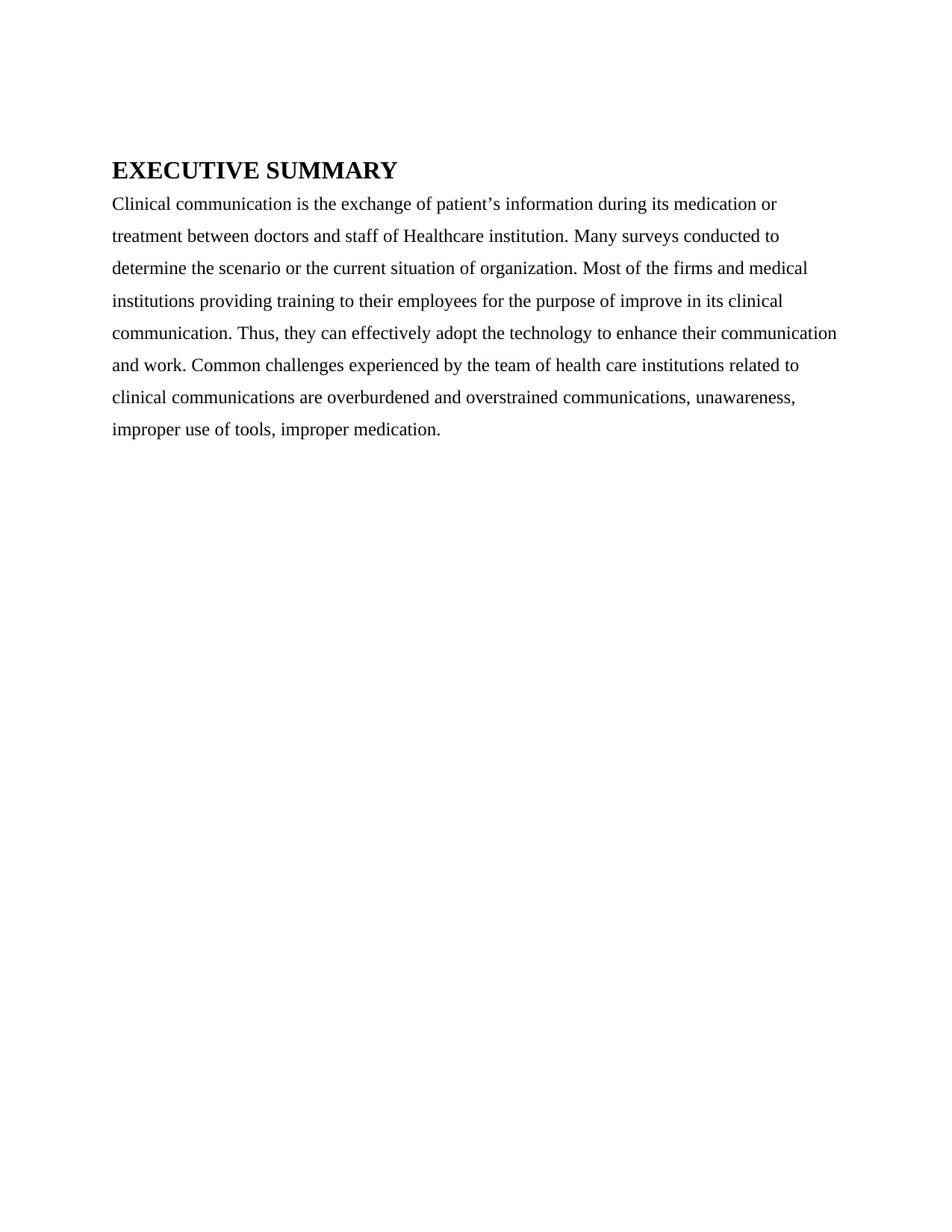
EXECUTIVE SUMMARY
Clinical communication is the exchange of patient’s information during its medication or
treatment between doctors and staff of Healthcare institution. Many surveys conducted to
determine the scenario or the current situation of organization. Most of the firms and medical
institutions providing training to their employees for the purpose of improve in its clinical
communication. Thus, they can effectively adopt the technology to enhance their communication
and work. Common challenges experienced by the team of health care institutions related to
clinical communications are overburdened and overstrained communications, unawareness,
improper use of tools, improper medication.
Clinical communication is the exchange of patient’s information during its medication or
treatment between doctors and staff of Healthcare institution. Many surveys conducted to
determine the scenario or the current situation of organization. Most of the firms and medical
institutions providing training to their employees for the purpose of improve in its clinical
communication. Thus, they can effectively adopt the technology to enhance their communication
and work. Common challenges experienced by the team of health care institutions related to
clinical communications are overburdened and overstrained communications, unawareness,
improper use of tools, improper medication.

⊘ This is a preview!⊘
Do you want full access?
Subscribe today to unlock all pages.

Trusted by 1+ million students worldwide
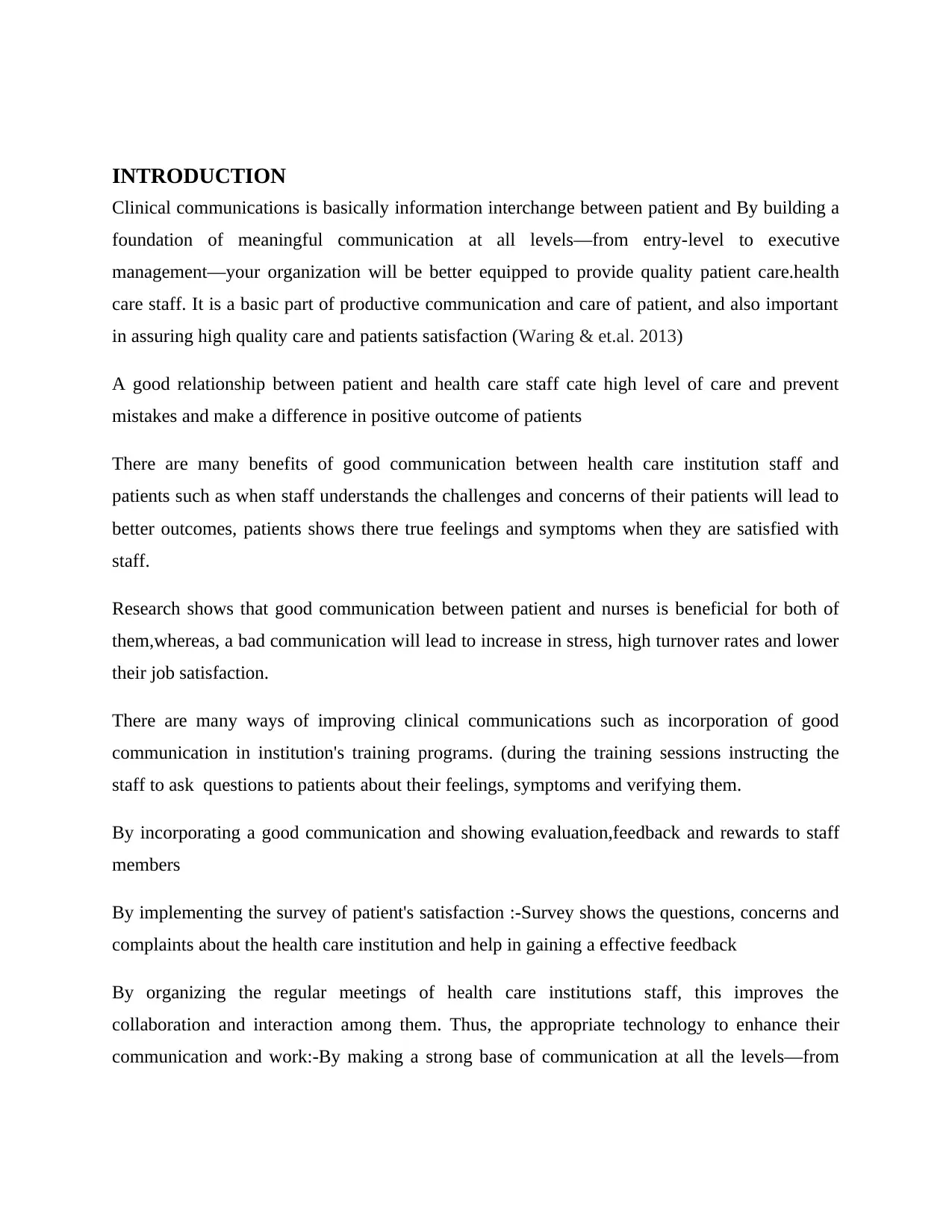
INTRODUCTION
Clinical communications is basically information interchange between patient and By building a
foundation of meaningful communication at all levels—from entry-level to executive
management—your organization will be better equipped to provide quality patient care.health
care staff. It is a basic part of productive communication and care of patient, and also important
in assuring high quality care and patients satisfaction (Waring & et.al. 2013)
A good relationship between patient and health care staff cate high level of care and prevent
mistakes and make a difference in positive outcome of patients
There are many benefits of good communication between health care institution staff and
patients such as when staff understands the challenges and concerns of their patients will lead to
better outcomes, patients shows there true feelings and symptoms when they are satisfied with
staff.
Research shows that good communication between patient and nurses is beneficial for both of
them,whereas, a bad communication will lead to increase in stress, high turnover rates and lower
their job satisfaction.
There are many ways of improving clinical communications such as incorporation of good
communication in institution's training programs. (during the training sessions instructing the
staff to ask questions to patients about their feelings, symptoms and verifying them.
By incorporating a good communication and showing evaluation,feedback and rewards to staff
members
By implementing the survey of patient's satisfaction :-Survey shows the questions, concerns and
complaints about the health care institution and help in gaining a effective feedback
By organizing the regular meetings of health care institutions staff, this improves the
collaboration and interaction among them. Thus, the appropriate technology to enhance their
communication and work:-By making a strong base of communication at all the levels—from
Clinical communications is basically information interchange between patient and By building a
foundation of meaningful communication at all levels—from entry-level to executive
management—your organization will be better equipped to provide quality patient care.health
care staff. It is a basic part of productive communication and care of patient, and also important
in assuring high quality care and patients satisfaction (Waring & et.al. 2013)
A good relationship between patient and health care staff cate high level of care and prevent
mistakes and make a difference in positive outcome of patients
There are many benefits of good communication between health care institution staff and
patients such as when staff understands the challenges and concerns of their patients will lead to
better outcomes, patients shows there true feelings and symptoms when they are satisfied with
staff.
Research shows that good communication between patient and nurses is beneficial for both of
them,whereas, a bad communication will lead to increase in stress, high turnover rates and lower
their job satisfaction.
There are many ways of improving clinical communications such as incorporation of good
communication in institution's training programs. (during the training sessions instructing the
staff to ask questions to patients about their feelings, symptoms and verifying them.
By incorporating a good communication and showing evaluation,feedback and rewards to staff
members
By implementing the survey of patient's satisfaction :-Survey shows the questions, concerns and
complaints about the health care institution and help in gaining a effective feedback
By organizing the regular meetings of health care institutions staff, this improves the
collaboration and interaction among them. Thus, the appropriate technology to enhance their
communication and work:-By making a strong base of communication at all the levels—from
Paraphrase This Document
Need a fresh take? Get an instant paraphrase of this document with our AI Paraphraser
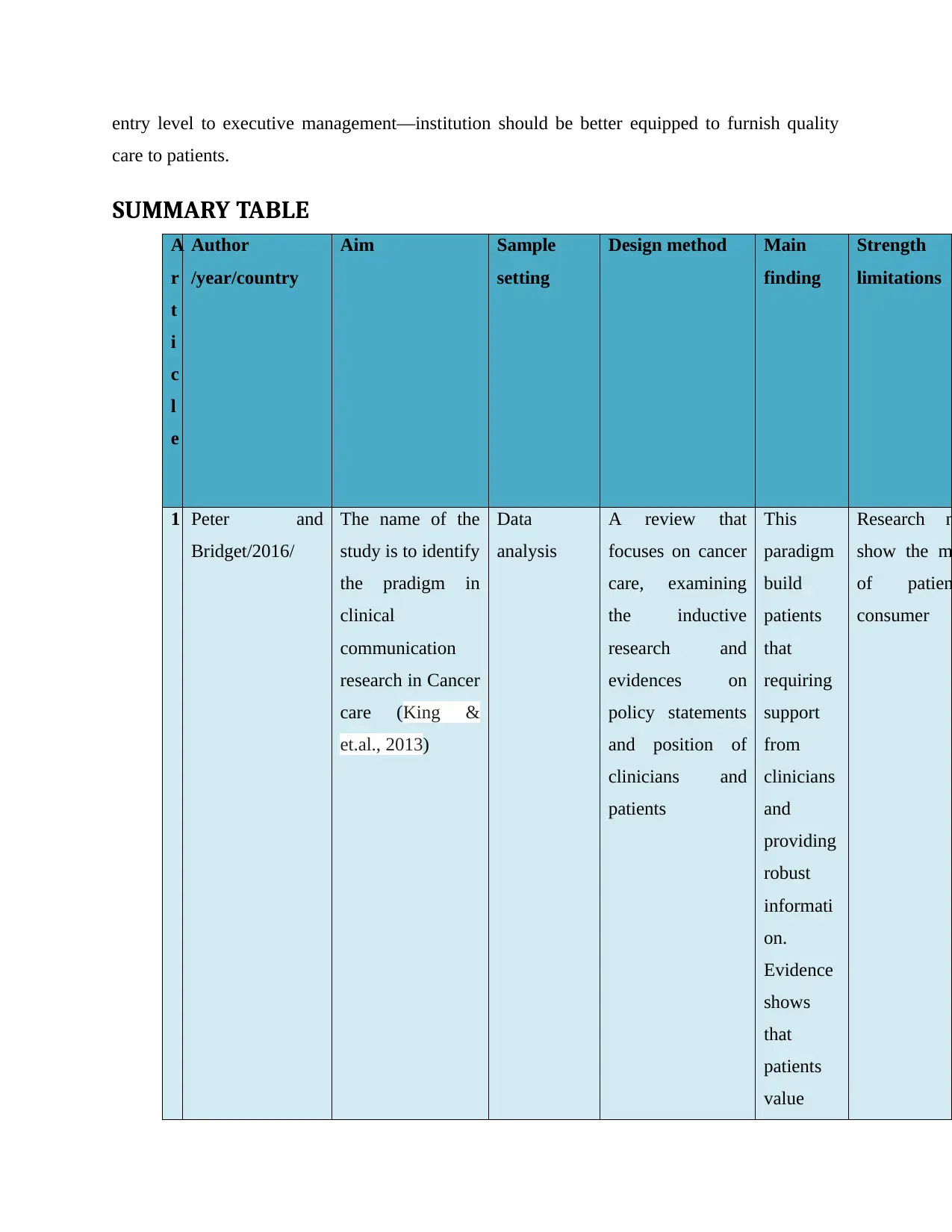
entry level to executive management—institution should be better equipped to furnish quality
care to patients.
SUMMARY TABLE
A
r
t
i
c
l
e
Author
/year/country
Aim Sample
setting
Design method Main
finding
Strength
limitations
1 Peter and
Bridget/2016/
The name of the
study is to identify
the pradigm in
clinical
communication
research in Cancer
care (King &
et.al., 2013)
Data
analysis
A review that
focuses on cancer
care, examining
the inductive
research and
evidences on
policy statements
and position of
clinicians and
patients
This
paradigm
build
patients
that
requiring
support
from
clinicians
and
providing
robust
informati
on.
Evidence
shows
that
patients
value
Research n
show the m
of patien
consumer
care to patients.
SUMMARY TABLE
A
r
t
i
c
l
e
Author
/year/country
Aim Sample
setting
Design method Main
finding
Strength
limitations
1 Peter and
Bridget/2016/
The name of the
study is to identify
the pradigm in
clinical
communication
research in Cancer
care (King &
et.al., 2013)
Data
analysis
A review that
focuses on cancer
care, examining
the inductive
research and
evidences on
policy statements
and position of
clinicians and
patients
This
paradigm
build
patients
that
requiring
support
from
clinicians
and
providing
robust
informati
on.
Evidence
shows
that
patients
value
Research n
show the m
of patien
consumer
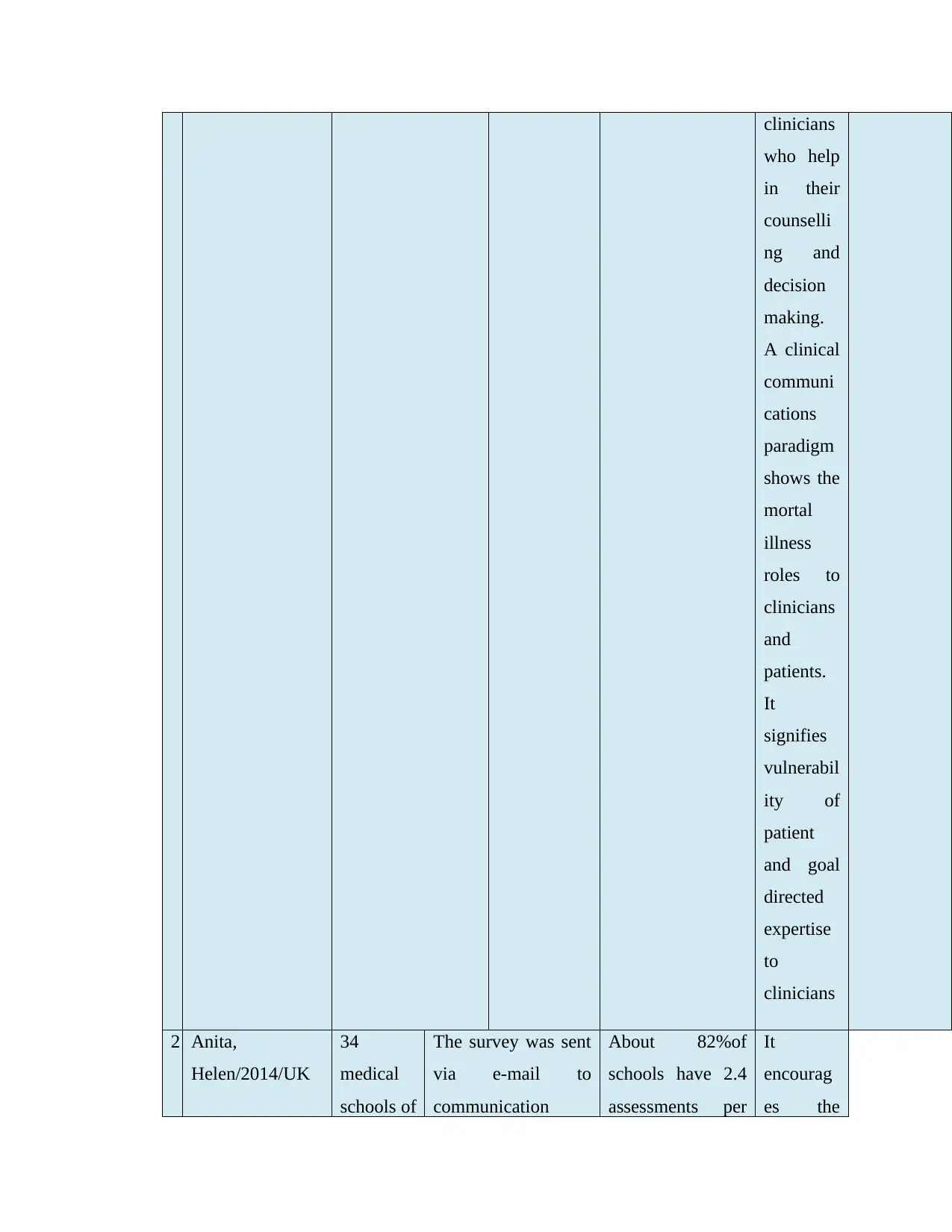
clinicians
who help
in their
counselli
ng and
decision
making.
A clinical
communi
cations
paradigm
shows the
mortal
illness
roles to
clinicians
and
patients.
It
signifies
vulnerabil
ity of
patient
and goal
directed
expertise
to
clinicians
2 Anita,
Helen/2014/UK
34
medical
schools of
The survey was sent
via e-mail to
communication
About 82%of
schools have 2.4
assessments per
It
encourag
es the
who help
in their
counselli
ng and
decision
making.
A clinical
communi
cations
paradigm
shows the
mortal
illness
roles to
clinicians
and
patients.
It
signifies
vulnerabil
ity of
patient
and goal
directed
expertise
to
clinicians
2 Anita,
Helen/2014/UK
34
medical
schools of
The survey was sent
via e-mail to
communication
About 82%of
schools have 2.4
assessments per
It
encourag
es the
⊘ This is a preview!⊘
Do you want full access?
Subscribe today to unlock all pages.

Trusted by 1+ million students worldwide
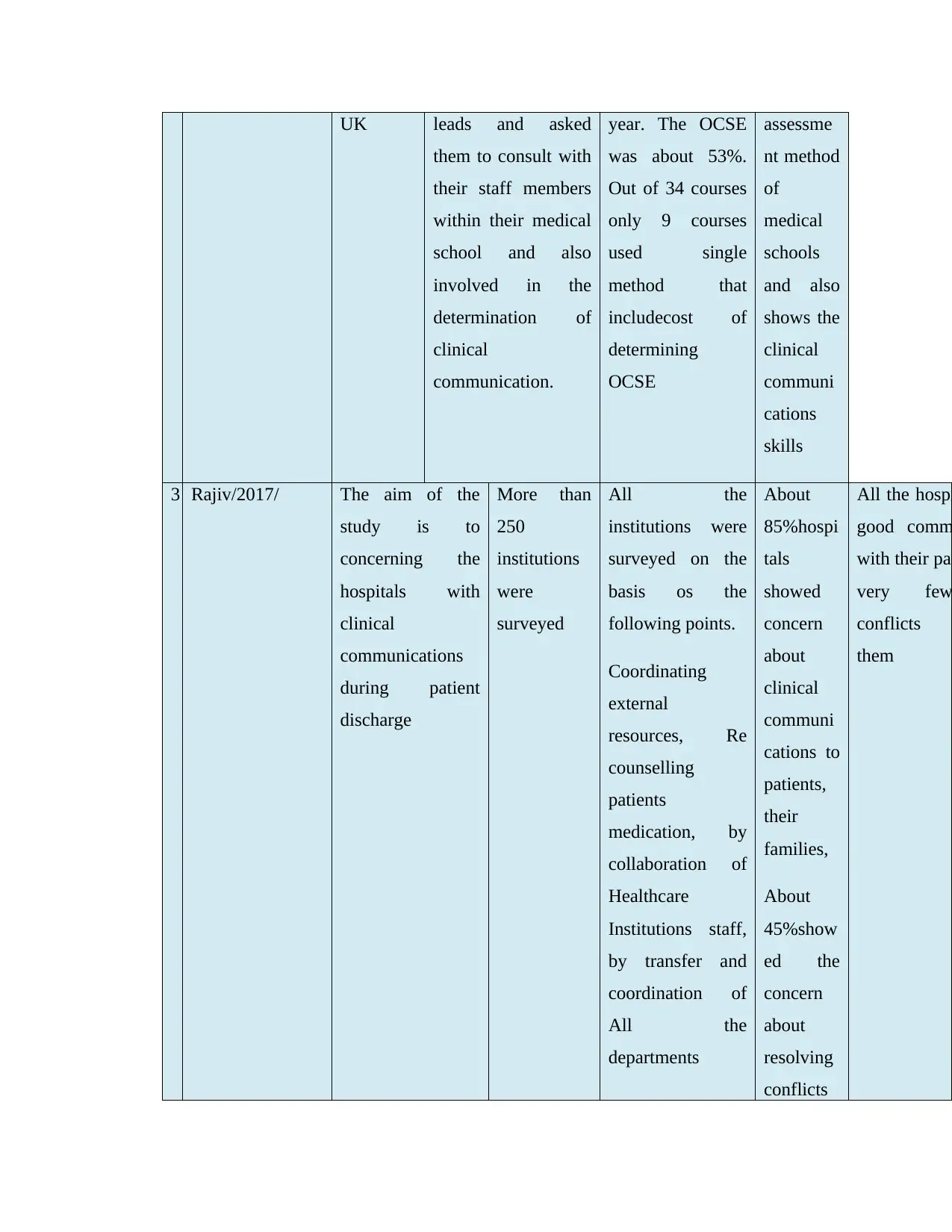
UK leads and asked
them to consult with
their staff members
within their medical
school and also
involved in the
determination of
clinical
communication.
year. The OCSE
was about 53%.
Out of 34 courses
only 9 courses
used single
method that
includecost of
determining
OCSE
assessme
nt method
of
medical
schools
and also
shows the
clinical
communi
cations
skills
3 Rajiv/2017/ The aim of the
study is to
concerning the
hospitals with
clinical
communications
during patient
discharge
More than
250
institutions
were
surveyed
All the
institutions were
surveyed on the
basis os the
following points.
Coordinating
external
resources, Re
counselling
patients
medication, by
collaboration of
Healthcare
Institutions staff,
by transfer and
coordination of
All the
departments
About
85%hospi
tals
showed
concern
about
clinical
communi
cations to
patients,
their
families,
About
45%show
ed the
concern
about
resolving
conflicts
All the hospi
good comm
with their pat
very few
conflicts
them
them to consult with
their staff members
within their medical
school and also
involved in the
determination of
clinical
communication.
year. The OCSE
was about 53%.
Out of 34 courses
only 9 courses
used single
method that
includecost of
determining
OCSE
assessme
nt method
of
medical
schools
and also
shows the
clinical
communi
cations
skills
3 Rajiv/2017/ The aim of the
study is to
concerning the
hospitals with
clinical
communications
during patient
discharge
More than
250
institutions
were
surveyed
All the
institutions were
surveyed on the
basis os the
following points.
Coordinating
external
resources, Re
counselling
patients
medication, by
collaboration of
Healthcare
Institutions staff,
by transfer and
coordination of
All the
departments
About
85%hospi
tals
showed
concern
about
clinical
communi
cations to
patients,
their
families,
About
45%show
ed the
concern
about
resolving
conflicts
All the hospi
good comm
with their pat
very few
conflicts
them
Paraphrase This Document
Need a fresh take? Get an instant paraphrase of this document with our AI Paraphraser
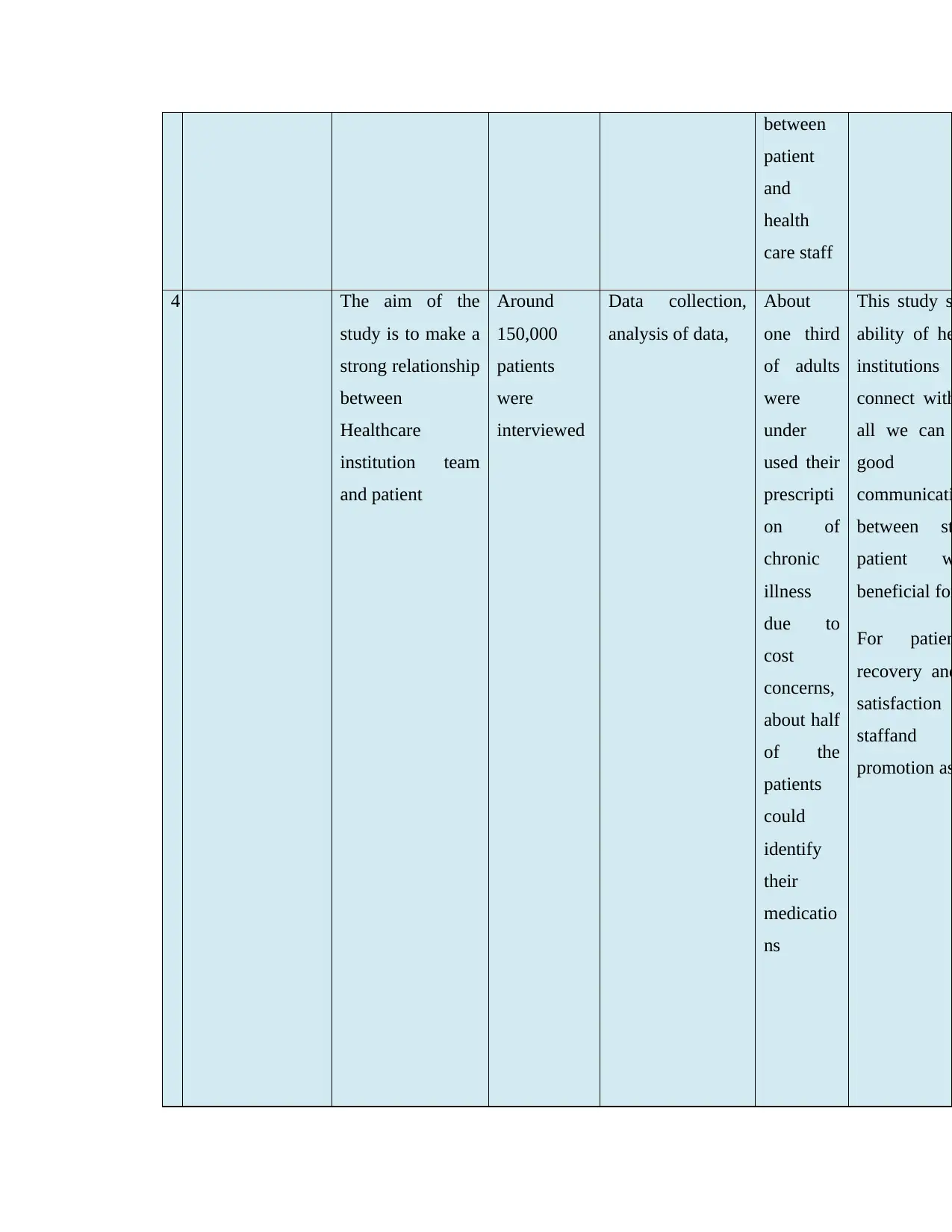
between
patient
and
health
care staff
4 The aim of the
study is to make a
strong relationship
between
Healthcare
institution team
and patient
Around
150,000
patients
were
interviewed
Data collection,
analysis of data,
About
one third
of adults
were
under
used their
prescripti
on of
chronic
illness
due to
cost
concerns,
about half
of the
patients
could
identify
their
medicatio
ns
This study s
ability of he
institutions
connect with
all we can
good
communicati
between st
patient w
beneficial for
For patien
recovery and
satisfaction
staffand
promotion as
patient
and
health
care staff
4 The aim of the
study is to make a
strong relationship
between
Healthcare
institution team
and patient
Around
150,000
patients
were
interviewed
Data collection,
analysis of data,
About
one third
of adults
were
under
used their
prescripti
on of
chronic
illness
due to
cost
concerns,
about half
of the
patients
could
identify
their
medicatio
ns
This study s
ability of he
institutions
connect with
all we can
good
communicati
between st
patient w
beneficial for
For patien
recovery and
satisfaction
staffand
promotion as
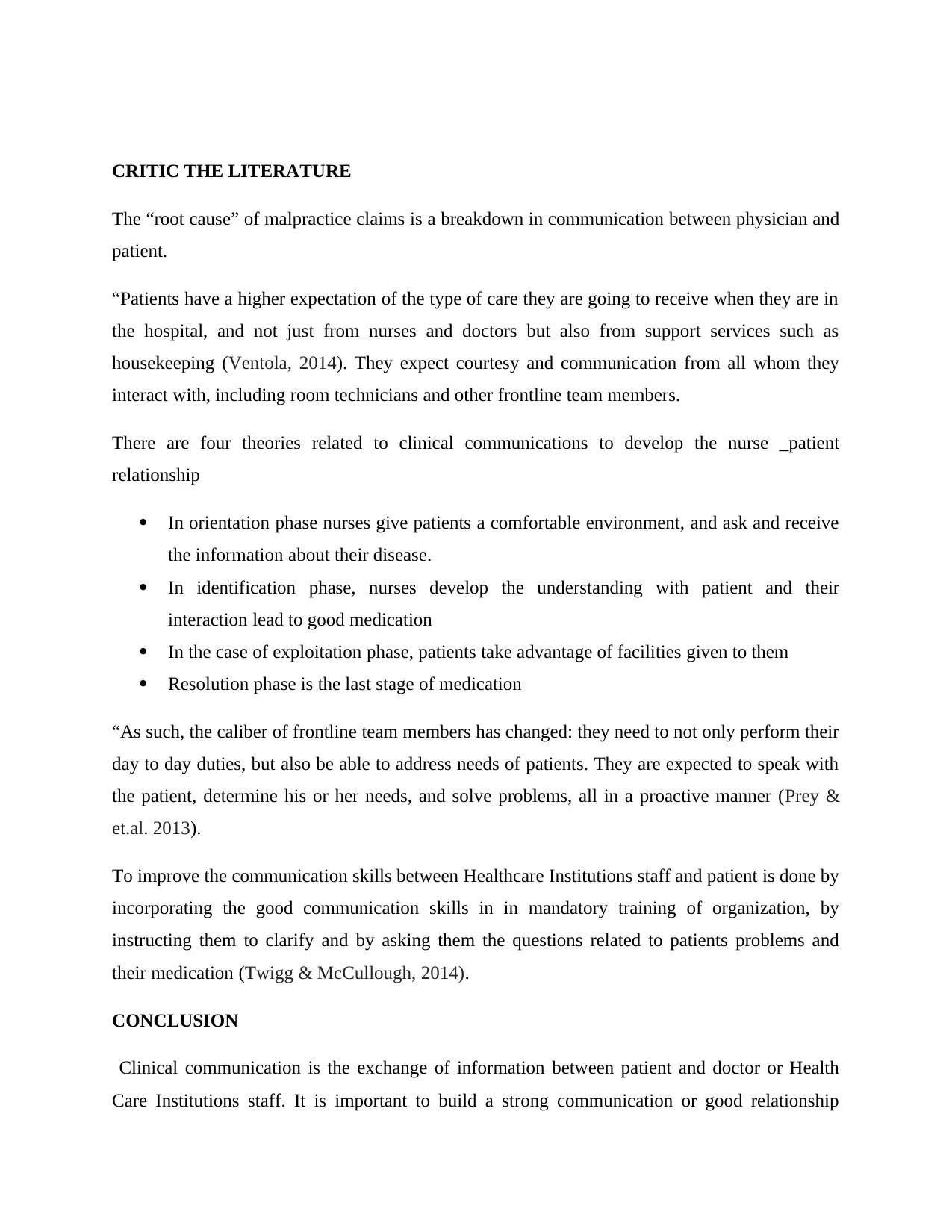
CRITIC THE LITERATURE
The “root cause” of malpractice claims is a breakdown in communication between physician and
patient.
“Patients have a higher expectation of the type of care they are going to receive when they are in
the hospital, and not just from nurses and doctors but also from support services such as
housekeeping (Ventola, 2014). They expect courtesy and communication from all whom they
interact with, including room technicians and other frontline team members.
There are four theories related to clinical communications to develop the nurse _patient
relationship
In orientation phase nurses give patients a comfortable environment, and ask and receive
the information about their disease.
In identification phase, nurses develop the understanding with patient and their
interaction lead to good medication
In the case of exploitation phase, patients take advantage of facilities given to them
Resolution phase is the last stage of medication
“As such, the caliber of frontline team members has changed: they need to not only perform their
day to day duties, but also be able to address needs of patients. They are expected to speak with
the patient, determine his or her needs, and solve problems, all in a proactive manner (Prey &
et.al. 2013).
To improve the communication skills between Healthcare Institutions staff and patient is done by
incorporating the good communication skills in in mandatory training of organization, by
instructing them to clarify and by asking them the questions related to patients problems and
their medication (Twigg & McCullough, 2014).
CONCLUSION
Clinical communication is the exchange of information between patient and doctor or Health
Care Institutions staff. It is important to build a strong communication or good relationship
The “root cause” of malpractice claims is a breakdown in communication between physician and
patient.
“Patients have a higher expectation of the type of care they are going to receive when they are in
the hospital, and not just from nurses and doctors but also from support services such as
housekeeping (Ventola, 2014). They expect courtesy and communication from all whom they
interact with, including room technicians and other frontline team members.
There are four theories related to clinical communications to develop the nurse _patient
relationship
In orientation phase nurses give patients a comfortable environment, and ask and receive
the information about their disease.
In identification phase, nurses develop the understanding with patient and their
interaction lead to good medication
In the case of exploitation phase, patients take advantage of facilities given to them
Resolution phase is the last stage of medication
“As such, the caliber of frontline team members has changed: they need to not only perform their
day to day duties, but also be able to address needs of patients. They are expected to speak with
the patient, determine his or her needs, and solve problems, all in a proactive manner (Prey &
et.al. 2013).
To improve the communication skills between Healthcare Institutions staff and patient is done by
incorporating the good communication skills in in mandatory training of organization, by
instructing them to clarify and by asking them the questions related to patients problems and
their medication (Twigg & McCullough, 2014).
CONCLUSION
Clinical communication is the exchange of information between patient and doctor or Health
Care Institutions staff. It is important to build a strong communication or good relationship
⊘ This is a preview!⊘
Do you want full access?
Subscribe today to unlock all pages.

Trusted by 1+ million students worldwide
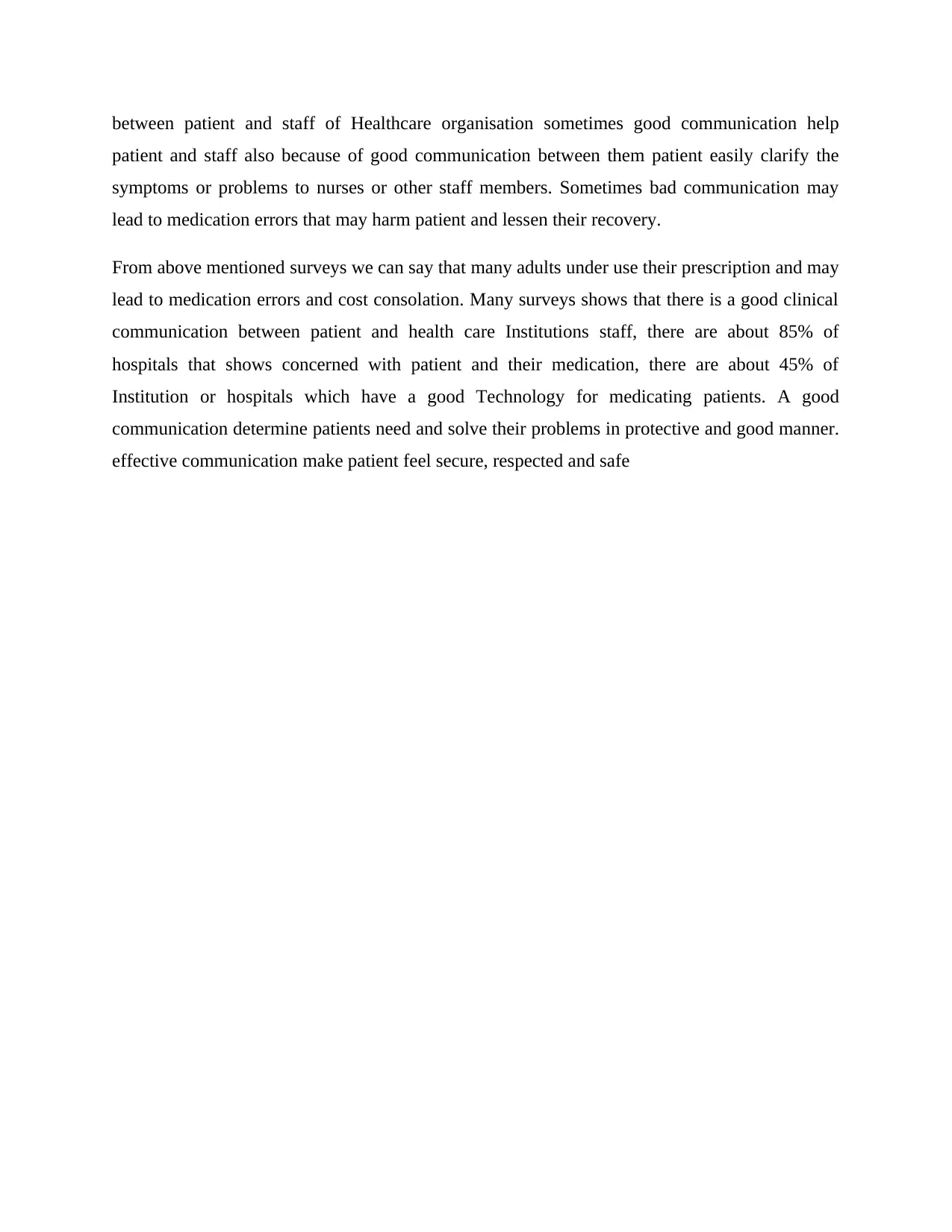
between patient and staff of Healthcare organisation sometimes good communication help
patient and staff also because of good communication between them patient easily clarify the
symptoms or problems to nurses or other staff members. Sometimes bad communication may
lead to medication errors that may harm patient and lessen their recovery.
From above mentioned surveys we can say that many adults under use their prescription and may
lead to medication errors and cost consolation. Many surveys shows that there is a good clinical
communication between patient and health care Institutions staff, there are about 85% of
hospitals that shows concerned with patient and their medication, there are about 45% of
Institution or hospitals which have a good Technology for medicating patients. A good
communication determine patients need and solve their problems in protective and good manner.
effective communication make patient feel secure, respected and safe
patient and staff also because of good communication between them patient easily clarify the
symptoms or problems to nurses or other staff members. Sometimes bad communication may
lead to medication errors that may harm patient and lessen their recovery.
From above mentioned surveys we can say that many adults under use their prescription and may
lead to medication errors and cost consolation. Many surveys shows that there is a good clinical
communication between patient and health care Institutions staff, there are about 85% of
hospitals that shows concerned with patient and their medication, there are about 45% of
Institution or hospitals which have a good Technology for medicating patients. A good
communication determine patients need and solve their problems in protective and good manner.
effective communication make patient feel secure, respected and safe
Paraphrase This Document
Need a fresh take? Get an instant paraphrase of this document with our AI Paraphraser
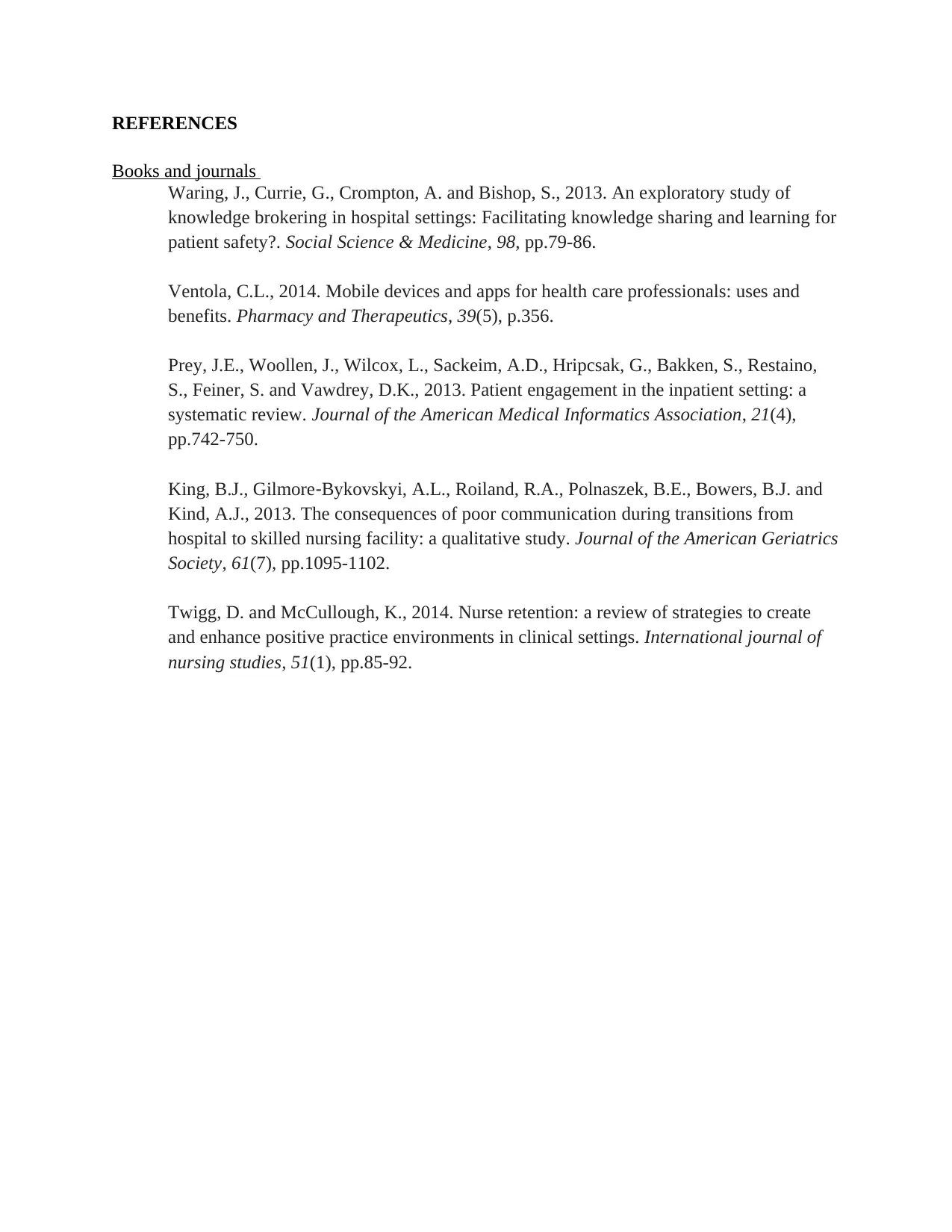
REFERENCES
Books and journals
Waring, J., Currie, G., Crompton, A. and Bishop, S., 2013. An exploratory study of
knowledge brokering in hospital settings: Facilitating knowledge sharing and learning for
patient safety?. Social Science & Medicine, 98, pp.79-86.
Ventola, C.L., 2014. Mobile devices and apps for health care professionals: uses and
benefits. Pharmacy and Therapeutics, 39(5), p.356.
Prey, J.E., Woollen, J., Wilcox, L., Sackeim, A.D., Hripcsak, G., Bakken, S., Restaino,
S., Feiner, S. and Vawdrey, D.K., 2013. Patient engagement in the inpatient setting: a
systematic review. Journal of the American Medical Informatics Association, 21(4),
pp.742-750.
King, B.J., Gilmore‐Bykovskyi, A.L., Roiland, R.A., Polnaszek, B.E., Bowers, B.J. and
Kind, A.J., 2013. The consequences of poor communication during transitions from
hospital to skilled nursing facility: a qualitative study. Journal of the American Geriatrics
Society, 61(7), pp.1095-1102.
Twigg, D. and McCullough, K., 2014. Nurse retention: a review of strategies to create
and enhance positive practice environments in clinical settings. International journal of
nursing studies, 51(1), pp.85-92.
Books and journals
Waring, J., Currie, G., Crompton, A. and Bishop, S., 2013. An exploratory study of
knowledge brokering in hospital settings: Facilitating knowledge sharing and learning for
patient safety?. Social Science & Medicine, 98, pp.79-86.
Ventola, C.L., 2014. Mobile devices and apps for health care professionals: uses and
benefits. Pharmacy and Therapeutics, 39(5), p.356.
Prey, J.E., Woollen, J., Wilcox, L., Sackeim, A.D., Hripcsak, G., Bakken, S., Restaino,
S., Feiner, S. and Vawdrey, D.K., 2013. Patient engagement in the inpatient setting: a
systematic review. Journal of the American Medical Informatics Association, 21(4),
pp.742-750.
King, B.J., Gilmore‐Bykovskyi, A.L., Roiland, R.A., Polnaszek, B.E., Bowers, B.J. and
Kind, A.J., 2013. The consequences of poor communication during transitions from
hospital to skilled nursing facility: a qualitative study. Journal of the American Geriatrics
Society, 61(7), pp.1095-1102.
Twigg, D. and McCullough, K., 2014. Nurse retention: a review of strategies to create
and enhance positive practice environments in clinical settings. International journal of
nursing studies, 51(1), pp.85-92.
1 out of 11
Related Documents
Your All-in-One AI-Powered Toolkit for Academic Success.
+13062052269
info@desklib.com
Available 24*7 on WhatsApp / Email
![[object Object]](/_next/static/media/star-bottom.7253800d.svg)
Unlock your academic potential
Copyright © 2020–2025 A2Z Services. All Rights Reserved. Developed and managed by ZUCOL.




